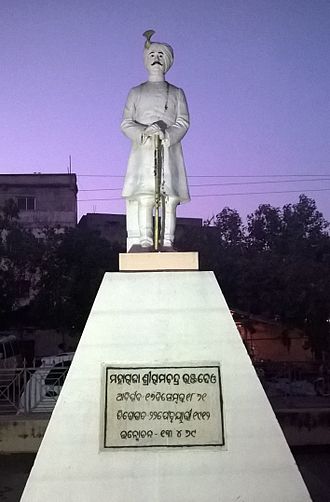The Ever-Shining Jewel of Mayurbhanj

Men and women come and go and most of them become only distant memories. A few however leave behind impression, powerful enough to continue to remain almost as living presence long after they have gone. Maharaja Sriram Chandra Bhanja Deo, no doubt has left a rich legacy behind him and indelible footprints on the sands of time.
Born on the 17th December 1871, Sriram Chandra was the son of Maharaja Krushna Chandra Bhanja Deo, the illustrious king of the Mayurbhanj State. Sriram Chandra was unfortunate enough to have lost his father, when he was barely 11 years of age and hence the state came under the administration of Court of Ward with Mr. P. Wylly as its manager. He assumed direct control of the State in 1890.
As a ruler of practical wisdom Sriram Chandra Bhanja Deo brought with him Sri Mohini Mohan Dhar, M.A.B.L. who was his private tutor in the Ravenshaw College at Cuttack and appointed him successively as Adviser, State Judge, Dewan and Vice-President of the State Council. Sri Mohini Mohan Dhar became the defacto counsellor of the Maharaja in all matters.

Maharaja Sriram Chandra Bhanja Deo could trace out the main causes of speedy development of other states and he had taken up the same process to develop his state to compete with or even surpass others. As an enlightened ruler he established State Council in 1893 to meet the requirements of a democratic Government. The Council introduced the criminal and civil codes as followed in the rest of India. Other Rules and Regulations on various aspects of administration like Tenancy, Revenue System, Stamps, Endowments etc. followed in succession. The office of the Auditor was organised. An attempt was made for separation of judiciary from executive and establishment of First Court of Appeal which was very advanced measure during those days. A general transformation from personal rule to departmental administration was organised.
Maharaja Sriram Chandra Bhanja Deo was an administrator Per-excellence. No better summary of the original position can be given than by a reproduction of the relevant portion on General Administration from Orissa Feudatory States Gazetteer (1907).
“For Administration purposes the Mayurbhanj State is divided into 3 subdivisions, viz. (i) The Sadar Sub-Division. (ii) Bamanghati Sub-division (iii) The Panchpir Sub-Division. A Council has been established since the year 1892 with Chief of State as President and the Dewan, the State Judge, the Superintendent of Police, the State Engineer and two Non-Official gentlemen as members. All legislative measures are to be passed by the Council and the Budget is discussed by the Council. The chief was the Dewan or any other member of council whom the Chief may nominate from judicial committee which bears appeals against the orders of all State Courts, according to the provision of the law of the state. The Dewan is the head of the Revenue Department including the Settlement, Agriculture and Zamindar and the Registration Departments. Under him is the Collector and a staff Deputy Collector and the sub-divisional officers in their capacity as Deputy Collectors. The State Judge is head of judicial side of the administration and has under him all Magistrates, Munsifs and SubJudges and the Sub-Divisional Officers in their capacity as Deputy Magistrate. In the SubDivision of Bamanghati and Panchpir, the SubDivisional Officers exercise both judicial and executive functions.
The Superintendent of Police and the State Engineer are in-charge of their respective Departments and deal direct with the Chief. The Chief Medical Officer, the Superintendents of Education and all other departments deal direct with the Chief and are immediately subordinate to him.
During the rule of Maharaja Sriram Chandra Bhanja Deo a network of roads was constructed for facilities of trade as well as of administration. In 1905 he planned for a road connecting the four Sub-Divisional head quarters towns of Baripada, Rairangpur, Karanjia and Udala. There was then a total length of 474.50 miles of road out of which more than 100 miles were metalled. In addition to it, the BengalNagpur Railways was induced to connect Baripada with the main B.N.R. Line at Rupsa Station. This helped further to develop the trade and commerce of the state and added to the welfare of the subjects. A Public Works Department was set up for planning and development of irrigation, roads and administration buildings.
Baripada, the headquarters of the State was greatly improved and beautified. It was provided with all modern amenities such as a High English School with an attached hostel and extensive play grounds, a fully equipped hospital for the treatment of both outdoor and indoor patients, an excellent public library, a beautiful public park and a leper Asylum outside the town to segregate the leper population of the state and for their proper treatment and rehabilitation. Telegraphic communication was also established with Calcutta, Cuttack and all important places in British India.
For smooth administration, Baripada Municipality was constituted on the 1st July 1905 under Mayurbhanj State Regulation of 1905. The Municipal area was divided into 6 wards and the number of Commissioners was 14 excluding the Chairman, 5 of them being official and 9 nonofficials.
Maharaja Sriram Chandra Bhanja Deo started a full-fledged state press at Baripada from which a monthly literary magazine called “Utkal Prava” was published in April 1891. Maharaja was aware of the iron deposits of Gorumohisani. He appointed the eminent geologist Sri Pramoth Nath Bose to survey it. This led to the Tata Lease in which the Dewan Sri Mohini Mohan Dhar played a leading role. It is well known how the Gorumahisani lease was the foundation of the Tata Iron and Steel Company.
The Maharaja was a patron of Chhau Dance and he presented a magnificent show of it before the British Emperor, George-V & Queen Mary at a pageant in Calcutta in 1912, which drew universal appreciation.
The rare combination of idealism and realism entitled Maharaja to the first place among the Bhanja Rulers of Mayurbhanj. It is no denying the fact that he could be regarded as one of the greatest kings of history and the evershining-jewel of Mayurbhanj.
Note : This article was first published in Orissa Review ( Dec 2005 ), Originally written by Shri Balabhadra Gadhei ( Principal of M.K. College, Khiching, Mayurbhanj-757039 )


[…] Maharaja Sriram Chandra Bhanj Deo […]